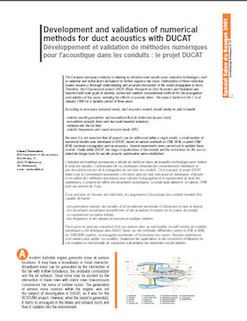Development and validation of numerical methods for duct acoustics with DUCAT
-
Auteur :
RADEMAKER E. -
Auteur moral :
-
Année de parution :
2001 -
Résumé :
The European aerospace industry is planning to introduce new nacelle noise reduction technologies such as adaptative and active liners (actuators) to further suppress fan noise. Optimisation of these reduction means requires a thorough understanding and accurate description of the sound propagation in ducts. Therefore, the EU-sponsored project DUCAT (Basic Research on Duct Acoustics and Radiation) was launched with main goals to develop, extend and validate computational methods for the propagation and radiation of fan, noise, including the effects of acoustic liners. The project started on the 1st of January 1998 for a duration period of three years. According to aerospace industrial needs, duct acoustics models should ideally be able to handle : - realistic nacelle geometries and non-uniform flow (in intake andby-pass duct), - non-uniform acoustic liners and duct wall mounted actuators, - radiation into the far field, - realistic frequencies and sound pressure level (SPL). Because it is not expected that all aspects can be adressed with a single model, a small number of numerical models was developed in DUCAT, based on various methods as FEM, BEM, coupled FEM/VEM, non-linear propagation and ray-acoustics. Several experiments were carried out to validate these models. Finally within DUCAT, the range of application of the models and the restrictions for the use as industrial design tools for nacelle acoustic optimisation were established. -
ISBN :
-
Thématique(s) :
Équipements, technologies et recherche, Transports et mobilités -
Type de contenu :
Article scientifique -
Mot(s) clé(s) :
-
Langue :
Anglais -
Disponible en prêt au CidB :
Oui -
Réf. CidB :
78/09578 -
Lien de téléchargement :


